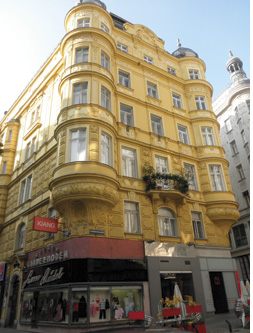Aside from Venice, whose Greek community we visited several months ago (March 2010), the lands of the Austro-Hungarian Empire were another key destination for “Hellenes without Borders” in the early phase of Greece’s modern Diaspora.
 Thus far, we have visited the Greek communities in Hungary (October 2010), and Trieste (November 2010). Now let us consider the history of the Greek community in Austria’s capital, Vienna.
Thus far, we have visited the Greek communities in Hungary (October 2010), and Trieste (November 2010). Now let us consider the history of the Greek community in Austria’s capital, Vienna.
Like other Greek communities in the ex-Austrian Empire, the Greeks’ large scale migration to the area followed the peace treaties between the Austrian and Ottoman Empires, most specifically the Treaty of Passarowitz, signed in 1717. Aside from fixing the boundaries between the two empires, a key provision was the right of Ottoman and Austrian subjects to engage in commerce in each other’s realm. After several decades of war, there was a great pent up demand for commerce and reconstruction. The Austrians lacked knowledge of the Ottoman Empire, and the Turks disdained commerce, so as a practical matter the opportunity fell on Ottoman minorities, Orthodox Greeks and Serbs, as well as Jews and Armenians.
The Vienna Greeks hailed primarily from Macedonia, Epirus, and particularly from Thracian cities such as Constantinople and Philippoupolis (modern Plovdiv, Bulgaria). Bulk goods, particularly cotton, were the lifeblood of the trade. Though legend has it that Greeks set up the first coffeehouse in Vienna, Dr. Theophanis Pampas, a local Greek Viennese doctor with an encyclopedic knowledge of the community, informed me that this singular honor goes to the Armenians. As I write these words, I am drinking Viennese coffee, which is exquisite.
The Greek community grew and prospered. In typical Greek fashion, factions appeared. Some Greeks took Austrian nationality and in many cases entered the Austrian nobility. Others retained Ottoman nationality, which had the benefit of lower taxation but restricted their activities to the mercantile sphere. Each faction then founded its own church, both within a hundred meters of the other, in Vienna’s Greichenviertel (Greek Quarter). These churches remain to this day, and liturgy alternates every Sunday from one church to the next.
Education and literacy in Greek were key endeavors of the Greek community, regardless of faction. The Vienna Greek school, which I had the honor to view one Saturday morning in progress, is older than the Greek state itself, founded in 1804. Even more importantly, Vienna is where Greek first appeared in print. The actual site of the first Greek printing press is gone, but within the Greek Quarter, a stately baroque Viennese building houses the second Greek printing press, where Rhegas Pheraios, the first martyr of Greek independence, edited the Greek newspaper. All Greek publications, particularly those in the Diaspora, in a very real sense descend from this site.

By the time of Greek independence in the 1820s, the Vienna community was at its acme, with about 5,000 members and an increasingly diverse socio-economic structure. The articulate and prosperous community naturally agitated for Greece’s liberation from the Ottoman yoke, but at the same time they were conscious that the Austrian Empire, a bundle of nationalities under a relatively benign but nonetheless absolute autocracy, was violently opposed to, and fearful of, revolution. Austrian Greeks therefore had to walk a very thin line between joy at Greece’s prospective independence and their personal safety and livelihood in the Austrian Empire. After all, the Austrians arrested Rhegas Pheraios and handed him over to the Turks, who strangled him in Belgrade in 1798. In Belgrade, the Serbs honor him with a statue and a street bearing his name, as he agitated for a pan-Balkan federation.
Greek independence did not result in a large repatriation of Austrian Greeks. The impoverished little kingdom could offer nothing in comparison to the vast Austrian Empire. The inexorable tide of assimilation began to absorb the Greeks into Austria’s ethnic goulash, and other Greek Austrians began to move to Britain or France, where the economies were more dynamic than Austria. A trickle of new immigrants arrived through the years, which, along with the efforts of the long established membership, kept the community intact.
The two World Wars increased pressure on the Greeks to assimilate, particularly during the barbaric Nazi era, but the religious community remained intact. Postwar, Austria had none of the mass immigration of Greek guestworkers like in neighboring Germany, but a fair amount of Greeks did go to Austria, particularly for study, and afterwards they often stayed in the country. This includes the current Deputy Mayor of Vienna, Greek-born Maria Vassilakou, a member of the Austrian Green Party.

Like Austria itself, the Greek Community of Vienna is a shadow of its former size, but still prosperous and elegant. Like the Greektowns of America, today’s Viennese Greeks rarely live in the area, but some do have businesses there, and the church and community hall, as always, functions as the community’s center of gravity. Like the other Greek communities we have “visited,” these Viennese “Hellenes without Borders” are living history of Greece’s perennial—and continuing—Diaspora.